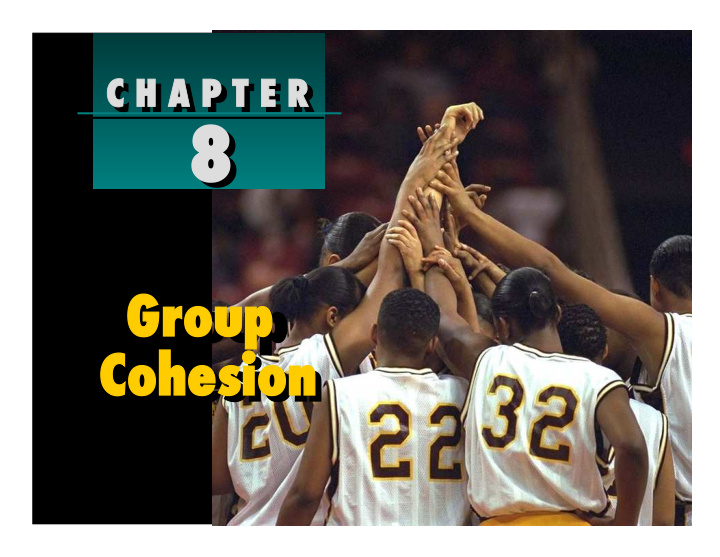



C C H A A P P T E E R C H A C A P P T E E R 8 � 8 � Gr Group oup � Group Gr oup � Coh Cohesi esion on Cohesi Coh esion on
Se Session Outline � Defining Cohesion � Carron’s Conceptual Model of Cohesion � Measuring Cohesion � The Cohesion-Performance Relationship � (continued)
Se Session Outline � Other Correlates of Cohesion � Enhancing Team Cohesion � – Exercise settings � – Sport settings � – Leader or coach strategies � – Group member strategies �
De Defining fining � Coh Cohesi esion on “A dynamic process reflected in the tendency for a group to stick together and remain united in the pursuit of its goals and objectives.” (Carron, 1982)
Defining Cohesion Task � The degree to which group members work together to cohesion � achieve common goals and objectives. Social � The interpersonal attractions among cohesion � group members.
Carron’s � Conceptual � Model of � Cohesion
Measuring Cohesion Questionnaires (e.g., Group Environment Questionnaire) focus on how attractive the group is to the individual members and how the members perceive the group. Group integration—task subscale Group integration—social subscale Individual attraction to group— task subscale Individual attraction to group— social subscale
Individual Attractions to the group - Task: Individual team member's feelings about her personal involvement with the group task, productivity, and goalsl and objectives. Individual Attractions to the group - Social: Individual team member's feelings about her personal involvement, acceptance and social interaction with the group. Group Integration-Task: Individual team member's feelings about the similarity, closeness and bonding within the team as a whole around the group's task. Group Integration-Social: Individual team member's feelings about the similarity, closeness and bonding within the team as a whole around the group as a social unit.
GEQ Conceptual Model
The Cohesion– � Performance Relationship Types of measures Positive cohesion-performance relationship with task cohesion measures. No cohesion-performance relationship with social cohesion measures.
Task Demands and the Cohesion–Performance Relationship
The Cohesion– � Performance Relationship Task demands Coacting teams (e.g., bowling): No cohesion-performance relationship. Interacting teams (e.g., volleyball): Cohesion increases performance.
The Cohesion– � Performance Relationship Circular relationship Increased cohesion leads to greater performance and brings teams together, which leads to still more increased cohesion. Still, the performance to cohesion relationship appears stronger than the cohesion to performance relationship.
Other Correlates � of Cohesion Team � Increased cohesion is satisfaction � related to increased satisfaction. Conformity � The more cohesive a group is, the greater its pressure to conform to the attitudes and behaviors of the group.
Other Correlates � of Cohesion Social � There is a positive support � relationship between the social support an individual receives and her or his evaluation of group cohesion.
Other Correlates � of Cohesion Stability � Teams higher in cohesion can better resist disruption; teams staying together longer tend to be more cohesive.
Enhancing Cohesion Exercise Setting Exercise classes with high feelings of group cohesion have fewer dropouts and late arrivals than do classes low in cohesion.
Creating an � Effective Team Climate Social support: Mutual respect and support enhances team climate. Proximity: Closer contact promotes team interaction. Distinctiveness: The more distinctive the group feels, the better the climate. (continued)
Creating an � Effective Team Climate Fairness: Fairness—or a lack of it— can bring a group closer together. Similarity: Greater similarity = closer climate.
Sample Strategies Suggested to Enhance Group Cohesiveness Increase distinctiveness by having a group name. wearing a group T-shirt. handing out neon shoelaces. making posters for class. (See Table 8.1 on page 179 of text)
Principles Underlying the Team–Building Program in a Sport Setting Coaches used several underlying principles to develop team-building programs, including leadership, distinctiveness, and sacrifices. (See Table 8.2 on page 180 of text)
Guidelines for Building Team Cohesion Leader-Coach Strategies Communicate effectively. Explain individual roles in team success. Develop pride within subunits. Set challenging team goals. (continued)
Guidelines for Building Team Cohesion Leader-Coach Strategies Encourage team identity. Discourage formation of social cliques. Avoid excessive turnover. (continued)
Guidelines for Building Team Cohesion Leader-Coach Strategies Conduct periodic team meetings. Know the team climate. Know something personal about each group member.
Guidelines for Building Team Cohesion Group Member Strategies Get to know members of the group. Help group members whenever possible. Give group members positive reinforcement. (continued)
Guidelines for Building Team Cohesion Group Member Strategies Be responsible. Communicate honestly and openly with coach or leader. Resolve conflicts immediately. Give 100% effort at all times.
Overcoming Barriers: Working in groups of 3 design strategies for overcoming these barriers • A clash of personalities in the group • A breakdown in communication between group members • One or more members struggling for power • Frequent turnover of group members
Recommend
More recommend